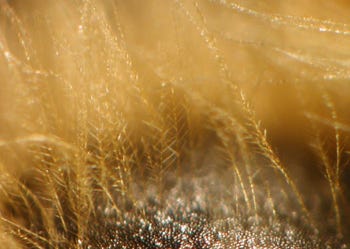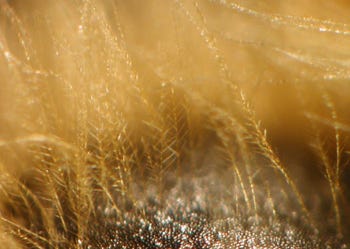Why are bees fuzzy? Is that really hair?
Many people are familiar with the fact that honey bees (and, with some exceptions, all bees) are fuzzy. They have little hairs on various parts of their bodies, and on different parts of their bodies depending on the type of bee. A fun scientific study that I stumbled across involved categorizing and ranking bees from fuzziest to smoothest. The winner for fuzziest bee was (no surprise), the bumblebees, followed by mason bees. So, honeybees are not by any means the furriest of the bees, but they are plenty furry.
But fur, or fuzz, or hair, is a feature that defines the whole group of bees. And, the fossil record seems to indicate that when fuzzy insects like bumblebees appeared on the scene here on earth, simultaneously the variety of flowering plants also exploded. This seems to be a beautiful case of co-evolution that begs the age-old question, "Which came first: the fabulous flowers or the fuzzy bees?"
Most of us know that those hairs all over the bees' bodies attract and hold pollen. A bee pollinating and gathering nectar gets covered head-to-abdomen in its labors, and drops a lot of pollen too, thus cross-pollinating her plant partners in the collecting process. On any given flight, bees know to visit only one certain type of flower in each flight, to fulfill their part of the marriage contract.
Bees not only have hair, but they have a number of different kinds of hair. Special rigid upward-curving hairs on the back legs of some bees, including honeybees, are adapted to hold lots of packed pollen for transport. These are called pollen baskets, or corpiculae. On their front legs, bees have stiff straight hairs projecting along the leg ridge which they use as a “comb” to brush the pollen grains down along their bodies back into the basket. What an amazing hair-based system!
So, hairiness in bees seems intimately connected to the insect-flower pollination relationship. Nor is it confined only to bees. Moths and butterflies give even bumblebees a run for their money in the fuzz competition.
And, of course, plants themselves utilize furry projections of various kinds for their own modes of living. Some, like in stinging nettle, provide defense, others trap moisture, prevent predation, or utilize wind motions in some way.
And this leads to the question regarding bees and other insects: "Is that really fur?". We know that mammals show up much later in the fossil record, and that mammalian bodies are entirely different from insects. Structurally, mammals (and amphibians and reptiles) have an internal skeleton, covered by muscles, skin and then hair. But insects are like an inversion of this arrangement. Their "hair" grows out of their exoskeleton, through a process called "invagination". The insect hairs grow out of an "infolding" of the exoskeleton surface. Insect exoskeletons are made of a substance called chitin, which one website I consulted likened chemically to cellulose. By contrast, mammalian hair is made from a group of proteins called keratins.
So, while they may both look like hair to us, bee and other insect fur seems to be much closer in substance to the fuzz on a lamb's ear plant than it is to my dog's warm fur coat. However, it is so fascinating that hair, or fur, or fuzz, seems to be a kind of archetypal structure in nature, one that has a myriad of uses, from sensing to warming, to pollinating and collecting, to protecting; and it is one that keeps appearing in the analogous morphology of so many living things.
The more I looked at this question, the more interesting it got and the more questions arose! Like, what is the significance of the fact that we humans are largely hairless compared to our mammalian family members, or that hair for us serves decorative, ceremonial, and mating functions? We’d better stop here for now. Let's not even get started right now on feathers or scales!
Closeup of hairs on the thorax of a worker bee. Notice that each hair is branched (plumose), enabling it to trap pollen grains more effectively. Photo courtesy of Zachary Huang. (taken from this website)



